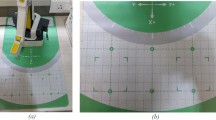Abstract
The use of interaction tools in modern work often challenges the human motor system, especially when these tools create awkward postures and discomfort (e.g., mouse arm syndrome). The question whether the trackball is a serious alternative to the mouse was evaluated in this experimental study in terms of motor performance, usability and comfort. In an applied pointing-selection task we varied gain and task difficulty. Results showed a considerably stronger impact of gain and task difficulty on the trackball than on the mouse, especially for the high gain trackball performance slowed down. Second, usability ratings were significantly better for the mouse than for the trackball (independent of the experimental condition). Finally, while the discomfort after mouse usage rose notably, trackball usage led to an even bigger increase in perceived discomfort.
Chapter PDF
Similar content being viewed by others
References
Hastings, S., Woods, V., Haslam, R.A., Buckle, P.: Health risks from mice and other non-keyboard input devices. In: McCabe, P.T., Hanson, M.A., Robertson, S.A. (eds.) Contemporary Ergonomics, pp. 312–316. Taylor & Francis, London (2000)
Burgess-Limerick, R., Shemmell, J., Scadden, R., Plooy, A.: Wrist posture during computer pointing device use. Clinical Biomechanics 14, 280–286 (1999)
Keir, P.J., Bach, J.M., Rempel, D.: Effects of computer design and task on carpal tunnel pressure. Ergonomics 42, 1350–1360 (1999)
ISO 9241-9: Ergonomic requirements for office work with visual display terminals – Part 9: Requirements for non-keyboard input devices. International Organization for Standardization. Beuth, Berlin (2000)
Heller, O.: Hörfeldaudiometrie mit dem Verfahren der Kategorienunterteilung (KU), Suprathreshold audiometry using the method of category partitioning (CP). Psychologische Beiträge 27, 478–493 (1985)
Proctor, R.W., Vu, K.-P.L.: Stimulus-Response-Compatibility Principles: Data, Theory, and Application. CRC Press - Taylor & Francis Group, New York (2006)
Sutter, C.: Sensumotor transformation of input devices and the impact on practice and task difficulty. Ergonomics 50, 1999–2016 (2007)
Sutter, C., Oehl, M., Armbrüster, C.: Practice and carryover effects when using small interaction devices. Applied Ergonomics 42, 437–444 (2011)
Sheridan, M.R.: A reappraisal of Fitts law. Journal of Motor Behavior 11, 179–188 (1979)
Sutter, C., Ziefle, M.: Psychomotor efficiency in users of notebook input devices: Confirmation and restrictions of Fitts’ law as an evaluative tool for user-friendly design. In: Proceedings of the Human Factors and Ergonomics Society 48th Annual Meeting, pp. 773–777 (2004)
Herring, S.R., Trejo, A.E., Hallbeck, M.S.: Evaluation of four cursor control devices during a target acquisition task for laparoscopic tool control. Applied Ergonomics 41, 47–57 (2010)
Author information
Authors and Affiliations
Editor information
Editors and Affiliations
Rights and permissions
Copyright information
© 2011 Springer-Verlag Berlin Heidelberg
About this paper
Cite this paper
Heber, I.A., Oehl, M., Sutter, C. (2011). Performance and Comfort When Using Motion-Controlled Tools in Complex Tasks. In: Stephanidis, C. (eds) HCI International 2011 – Posters’ Extended Abstracts. HCI 2011. Communications in Computer and Information Science, vol 174. Springer, Berlin, Heidelberg. https://doi.org/10.1007/978-3-642-22095-1_68
Download citation
DOI: https://doi.org/10.1007/978-3-642-22095-1_68
Publisher Name: Springer, Berlin, Heidelberg
Print ISBN: 978-3-642-22094-4
Online ISBN: 978-3-642-22095-1
eBook Packages: Computer ScienceComputer Science (R0)




